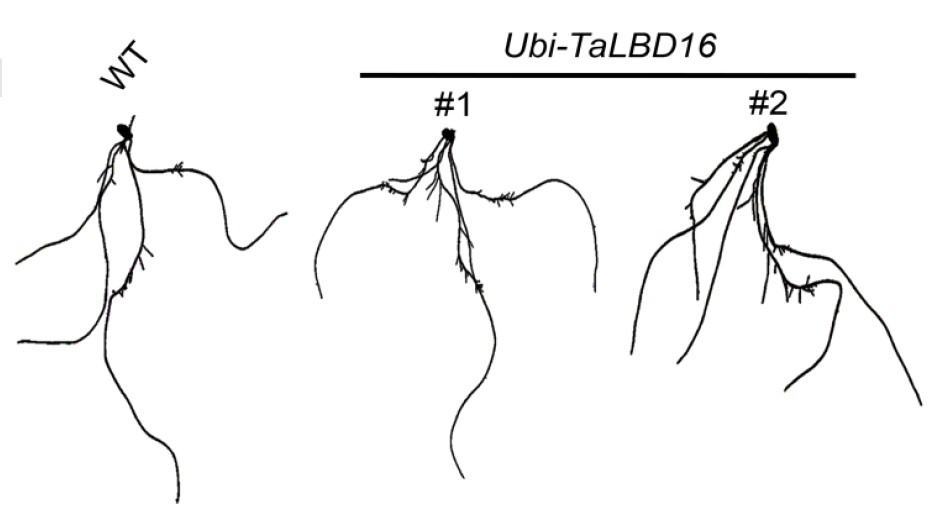博文
the plant journal:六倍体小麦演化过程中侧根数量的改变
||
Three genomes differentially contribute to the seedling lateral root number in allohexaploid wheat: Evidence from phenotype evolution and gene expression
First author: Huifang Wang; Affiliations: China Agricultural University (中国农业大学): Beijing, China
Corresponding author: Zhongfu Ni (倪中福)
Common wheat is an allohexaploid (BBAADD; 异源六倍体) that originated from the hybridization and polyploidization of the diploid Aegilops tauschii (DD; 节节麦) with the allotetraploid Triticum turgidum (BBAA; 圆锥小麦). Phenotypic changes often arise with the formation and evolution of allopolyploid wheat, but little is known about their evolution in different wheat species with varying ploidy levels. Here, we reported that the lateral root number on the primary root (LRNPR) of synthetic and natural allohexaploid wheats (BBAADD) is significantly higher than that of their allotetraploid (BBAA) and diploid progenitors (AA and SS) but much lower than that of their diploid progenitors (DD). The expression of the wheat gene TaLBD16, an orthologue of the Arabidopsis LATERAL ORGAN BOUNDARIES‐DOMAIN16/ASYMMETRIC LEAVES2‐LIKE18 (LBD16), which is involved in lateral root development in Arabidopsis, was positively correlated with the LRNPR in diploid and allopolyploid wheats. In natural and synthetic allohexaploid wheats, the transcript of the TaLBD16 from the D genome (TaLBD16‐D) was relatively more abundant compared to TaLBD16‐A and TaLBD16‐B. Consistent with the observed variation in LRNPR, the divergence in the expression of TaLBD16 homoeologous genes occurred before the formation of polyploidy wheat. Collectively, our observations indicate that the D genome played a crucial role in the increased lateral root number of allohexaploid wheats compared to their allotetraploid progenitors, and TaLBD16‐D was one of the key genes involved in the formation of lateral root number during wheat evolution.
普通的小麦是异源六倍体(BBAADD),起源于二倍体节节麦(DD)和异源四倍体圆锥小麦(BBAA)的杂交和多倍化。随着异源多倍体小麦的形成和演化,表型会发生明显的变化,但目前对于不同倍性水平的小麦物种的演化还所知甚少。本文报道了无论是人工合成亦或是自然形成的异源六倍体小麦(BBAADD)主根上面侧根的数量LRNPR均要显著高于其异源四倍体祖先(BBAA)和二倍体祖先(AA和SS),但要比二倍体祖先(DD)低得多。拟南芥参与侧根发育的LBD16基因在小麦中直系同源基因TaLBD16的表达与二倍体和异源多倍体小麦的LRNPR正相关。在自然形成和人工合成的异源六倍体小麦中,来自D染色体的TaLBD16基因的表达要比来自其它两套染色体上TaLBD16基因的表达要更加富集。与观测到的LRNPR变异一致,TaLBD16旁系同源基因表达的分化在多倍体小麦形成之前就已经发生。综上,本文的发现揭示了D套染色体组对于异源六倍体小麦侧根数量的增加要比其异源四倍体祖先更加重要,并且TaLBD16‐D基因是小麦演化过程中参与侧根数量形成的关键基因。
通讯:倪中福 (http://cab.cau.edu.cn/art/2017/6/12/art_27218_153.html)
doi: https://doi.org/10.1111/tpj.14005
Journal: the plant journal
First Published: 22 June, 2018
(P.S. 原文下载:链接:https://pan.baidu.com/s/1qFiSsqwlF_7JjmGMbedfhQ 密码:dmu6)
https://blog.sciencenet.cn/blog-3158122-1120887.html
上一篇:Plant Physiology:茉莉酸抑制生长素诱导的拟南芥侧根形成
下一篇:Nature Plants:生长素信号调控根发育的新机制
全部作者的其他最新博文
- • Plant Physiology:CsMADS3促进柑果中的叶绿素降解和类胡萝卜素合成(华中农业大学)
- • Molecular Plant:LBD11-ROS反馈调节作用于拟南芥的维管形成层增殖和次生生长(浦项科技大学)
- • Science Advances:根结线虫通过调控植物的CLE3-CLV1模块,促进侵染进程(日本熊本大学)
- • Nature Communications:油菜素内酯参与植物营养生长期转变的分子机制解析(浙江农林大学)
- • Current Biology:光合作用产生的蔗糖驱动侧根“生物钟”(德国弗莱堡大学)
- • PNAS:花同源异型基因在叶中被抑制、花中被激活的分子机制(南卡罗来纳大学)


